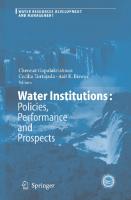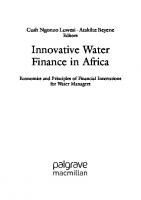The Economics of Water: Rules and Institutions 9783030484842
This open access textbook provides a concise introduction to economic approaches and mathematical methods for the study
277 86 6MB
English Pages 320 [312] Year 2020
Table of contents :
Contents
Symbols
List of Figures
List of Tables
List of Boxes
1 Introduction
1.1 Introduction
1.2 State of the Literature and the Specifics of Our Approach
1.3 A Novel Technical-Economic Approach
1.4 Structure of This Book
1.5 Important Topics Not Covered
2 Water Availability: A Hydrological View
2.1 Global Water Resources and Water Cycle
2.2 The Regional Water Cycle
2.3 A Simplified Hydro-Economic Model
2.4 Exercises
2.5 Further Reading
3 Integrated Water Resource Management: Principles and Applications
3.1 What Is Integrated Water Resource Management?
3.1.1 Approaches to IWRM
3.1.2 The IWRM Paradigm
3.1.3 A General Framework for IWRM
3.2 The Economic Dimension of Water
3.2.1 Types of Environmental Goods
3.2.2 Economic Dimensions of Water
3.3 Social Welfare, Scarcity, and the Value of Water
3.3.1 Fairness Criteria
3.3.2 Social Welfare Function
3.3.3 Allocation with and without Water Scarcity
3.4 Eco-Hydrology and the Management of Water as a Public Good
3.5 Water Allocation and the Human Right to Water
3.5.1 Millennium Goal 7 and Sustainable Development Goal 6: Water
3.5.2 Water Management for the Very Poor
3.5.3 A Water Market with Extremely Poor Households
3.6 Water Recycling
3.6.1 Nomenclature of Water Recycling
3.6.2 Optimal Recycling
3.6.3 Markets for Recycled Water
3.7 Water Allocation Along Rivers
3.7.1 Basic Model
3.7.2 Two Cases of Upstream Behavior with Scarcity
3.7.3 Two Cases Without Scarcity in One Region
3.8 Groundwater Management
3.8.1 A Simple Groundwater Model
3.8.2 Dynamic Stock Balance for Groundwater
3.8.3 Hydrological and Ecologic Effects
3.9 Water Transfer Between Watersheds
3.9.1 Inter-basin Water Transfer Schemes
3.9.2 Transfer from Water-Rich to Water-Scarce Regions
3.9.3 Transfer Between Two Water-Scarce Regions
3.10 Water Quality Management
3.10.1 Water Pollution: An Unresolved Issue
3.10.2 Water Quality Management
3.10.3 Optimal Water Quality
3.11 Exercises
3.12 Further Reading
3.13 Chapter Annex: Integrated Water Resource Management
3.13.1 The Dublin Principles
3.13.2 Integration in IWRM
3.13.3 Implementation of IWRM
4 Water Tariffs
4.1 Historical Review of the Water Pricing Debate
4.2 Criteria for Water Tariffs
4.2.1 Revenue Sufficiency
4.2.2 Economic Efficiency
4.2.3 Environmental Sustainability
4.2.4 Social Concerns
4.3 Water Tariff Design
4.3.1 Tariff Structures
4.3.2 Price Discrimination
4.3.3 Two-Part Tariff Versus One-Part Tariff
4.3.4 Universal Service Provider
4.3.5 Optional Tariffs
4.3.6 Seasonal Pricing
4.4 Increasing Block Tariffs
4.4.1 The Concept
4.4.2 Potential Adverse Effects on the Poor
4.4.3 Further Considerations
4.5 Pricing in Unconnected Water Markets
4.5.1 Stylized Facts
4.5.2 Model
4.6 Water Scarcity: Prices Versus Rationing
4.6.1 Options to Deal with Scarcity
4.6.2 Rationing
4.6.3 Comparison
4.6.4 Discussion
4.7 Exercises
4.8 Further Reading
4.9 Chapter-Annex: Overview of Water Tariff Structures
5 Water Markets
5.1 Institutional, Hydrological and Infrastructural Preconditions
5.1.1 Design of Water Markets
5.1.2 Transaction Costs and Institutional Factors
5.2 A Water Market Model
5.2.1 Water Markets and Return Flows
5.2.2 Water Markets and Instream Constraints
5.3 Water Entitlements and Water Allocations
5.4 Exercises
5.5 Further Reading
6 Transboundary Water Resource Management
6.1 Water Rivalry, Agreements, and International Water Rights
6.2 Benefit Sharing Between Two Riparians
6.2.1 Principles of Benefit Sharing
6.2.2 UID, DID and the Shapley Solution
6.3 Benefit Sharing Between More Than Two Riparians
6.3.1 Model of a River Basin
6.3.2 Benefit Sharing in the Grand Coalition: Four Approaches
6.3.3 Concluding Remarks on the Benefit Sharing Problem
6.4 Bankruptcy Rules for Water Allocation
6.4.1 Principles of Bankruptcy Rules
6.4.2 Hydrologically Unconstrained Allocation Rules
6.4.3 Sequential Allocation Rules
6.5 Flexible Water Sharing
6.6 An Institutional Perspective on Transboundary Water Agreements
6.6.1 An Institutional Approach
6.6.2 Principles for Effective Institutional Development
6.6.3 Idealtypes of Governance
6.6.4 Application to Transboundary Agreements
6.7 Exercises
6.8 Further Reading
6.9 Chapter-Annex: Step-by-Step Solution of Optimization Problems of Sect.6.3
Appendix: Karush–Kuhn–Tucker Conditions
Contents
Symbols
List of Figures
List of Tables
List of Boxes
1 Introduction
1.1 Introduction
1.2 State of the Literature and the Specifics of Our Approach
1.3 A Novel Technical-Economic Approach
1.4 Structure of This Book
1.5 Important Topics Not Covered
2 Water Availability: A Hydrological View
2.1 Global Water Resources and Water Cycle
2.2 The Regional Water Cycle
2.3 A Simplified Hydro-Economic Model
2.4 Exercises
2.5 Further Reading
3 Integrated Water Resource Management: Principles and Applications
3.1 What Is Integrated Water Resource Management?
3.1.1 Approaches to IWRM
3.1.2 The IWRM Paradigm
3.1.3 A General Framework for IWRM
3.2 The Economic Dimension of Water
3.2.1 Types of Environmental Goods
3.2.2 Economic Dimensions of Water
3.3 Social Welfare, Scarcity, and the Value of Water
3.3.1 Fairness Criteria
3.3.2 Social Welfare Function
3.3.3 Allocation with and without Water Scarcity
3.4 Eco-Hydrology and the Management of Water as a Public Good
3.5 Water Allocation and the Human Right to Water
3.5.1 Millennium Goal 7 and Sustainable Development Goal 6: Water
3.5.2 Water Management for the Very Poor
3.5.3 A Water Market with Extremely Poor Households
3.6 Water Recycling
3.6.1 Nomenclature of Water Recycling
3.6.2 Optimal Recycling
3.6.3 Markets for Recycled Water
3.7 Water Allocation Along Rivers
3.7.1 Basic Model
3.7.2 Two Cases of Upstream Behavior with Scarcity
3.7.3 Two Cases Without Scarcity in One Region
3.8 Groundwater Management
3.8.1 A Simple Groundwater Model
3.8.2 Dynamic Stock Balance for Groundwater
3.8.3 Hydrological and Ecologic Effects
3.9 Water Transfer Between Watersheds
3.9.1 Inter-basin Water Transfer Schemes
3.9.2 Transfer from Water-Rich to Water-Scarce Regions
3.9.3 Transfer Between Two Water-Scarce Regions
3.10 Water Quality Management
3.10.1 Water Pollution: An Unresolved Issue
3.10.2 Water Quality Management
3.10.3 Optimal Water Quality
3.11 Exercises
3.12 Further Reading
3.13 Chapter Annex: Integrated Water Resource Management
3.13.1 The Dublin Principles
3.13.2 Integration in IWRM
3.13.3 Implementation of IWRM
4 Water Tariffs
4.1 Historical Review of the Water Pricing Debate
4.2 Criteria for Water Tariffs
4.2.1 Revenue Sufficiency
4.2.2 Economic Efficiency
4.2.3 Environmental Sustainability
4.2.4 Social Concerns
4.3 Water Tariff Design
4.3.1 Tariff Structures
4.3.2 Price Discrimination
4.3.3 Two-Part Tariff Versus One-Part Tariff
4.3.4 Universal Service Provider
4.3.5 Optional Tariffs
4.3.6 Seasonal Pricing
4.4 Increasing Block Tariffs
4.4.1 The Concept
4.4.2 Potential Adverse Effects on the Poor
4.4.3 Further Considerations
4.5 Pricing in Unconnected Water Markets
4.5.1 Stylized Facts
4.5.2 Model
4.6 Water Scarcity: Prices Versus Rationing
4.6.1 Options to Deal with Scarcity
4.6.2 Rationing
4.6.3 Comparison
4.6.4 Discussion
4.7 Exercises
4.8 Further Reading
4.9 Chapter-Annex: Overview of Water Tariff Structures
5 Water Markets
5.1 Institutional, Hydrological and Infrastructural Preconditions
5.1.1 Design of Water Markets
5.1.2 Transaction Costs and Institutional Factors
5.2 A Water Market Model
5.2.1 Water Markets and Return Flows
5.2.2 Water Markets and Instream Constraints
5.3 Water Entitlements and Water Allocations
5.4 Exercises
5.5 Further Reading
6 Transboundary Water Resource Management
6.1 Water Rivalry, Agreements, and International Water Rights
6.2 Benefit Sharing Between Two Riparians
6.2.1 Principles of Benefit Sharing
6.2.2 UID, DID and the Shapley Solution
6.3 Benefit Sharing Between More Than Two Riparians
6.3.1 Model of a River Basin
6.3.2 Benefit Sharing in the Grand Coalition: Four Approaches
6.3.3 Concluding Remarks on the Benefit Sharing Problem
6.4 Bankruptcy Rules for Water Allocation
6.4.1 Principles of Bankruptcy Rules
6.4.2 Hydrologically Unconstrained Allocation Rules
6.4.3 Sequential Allocation Rules
6.5 Flexible Water Sharing
6.6 An Institutional Perspective on Transboundary Water Agreements
6.6.1 An Institutional Approach
6.6.2 Principles for Effective Institutional Development
6.6.3 Idealtypes of Governance
6.6.4 Application to Transboundary Agreements
6.7 Exercises
6.8 Further Reading
6.9 Chapter-Annex: Step-by-Step Solution of Optimization Problems of Sect.6.3
Appendix: Karush–Kuhn–Tucker Conditions

![The Economics of Water: Rules and Institutions [1st ed.]
9783030484842, 9783030484859](https://ebin.pub/img/200x200/the-economics-of-water-rules-and-institutions-1st-ed-9783030484842-9783030484859.jpg)


![The economics of industrial water use [4]
1840644990](https://ebin.pub/img/200x200/the-economics-of-industrial-water-use-4-1840644990.jpg)


![Experimental Economics: Rethinking the Rules [Course Book ed.]
9781400831432](https://ebin.pub/img/200x200/experimental-economics-rethinking-the-rules-course-booknbsped-9781400831432.jpg)


![The Governance of Telecom Markets: Economics, Law and Institutions in Europe [1st ed.]
9783030581596, 9783030581602](https://ebin.pub/img/200x200/the-governance-of-telecom-markets-economics-law-and-institutions-in-europe-1st-ed-9783030581596-9783030581602.jpg)